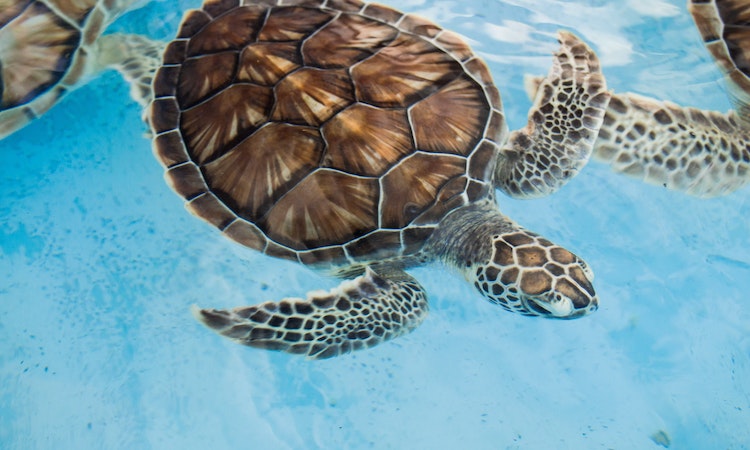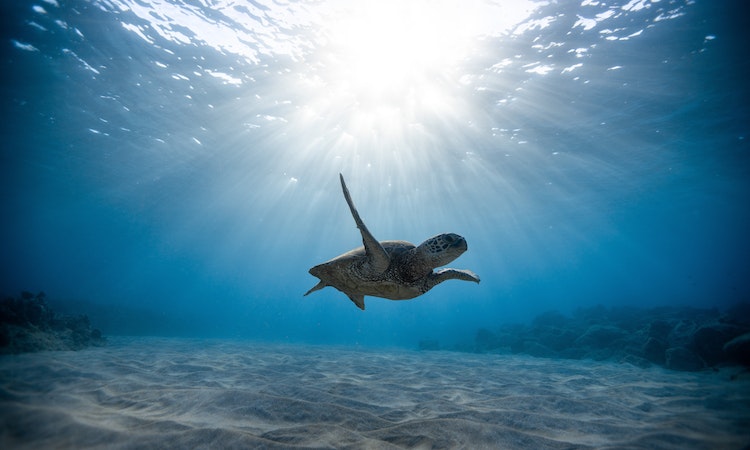While turtles typically move slowly on land, they are much more agile in water. They may not be as quick as orcas, but sea turtles can still swim relatively fast.
Surprisingly, leatherback sea turtles can swim up to 34 kilometers per hour (or 21 miles per hour)! Perhaps it’s because they don’t have any teeth to defend themselves. Similarly, pet turtles are also quite speedy in water due to their natural swimming abilities.
If you’re wondering about out of water, softshell turtles have been seen moving at speeds of 3 miles per hour on land.

How Fast is a Turtle in Water?
Turtles are from the order Chelonia, and as a result, they are often interchangeably called chelonians. The term turtles usually describe aquatic turtles, semi-aquatic turtles, and tortoises.
Thanks to their tough outer shell, turtles are very safe from attack. This armor defends them against all sorts of predators, so it’s no surprise that they’re one of the oldest survivors among all reptiles. They were around even during the time of dinosaurs!
Although it’s crucial to have a tough shell, turtles also need to be able book it when necessary. Many of them are deceptively speedy, especially in water.
The average sea turtle speed is 10 to 12 miles per hour. Of course, they cannot maintain this speed over longer distances such as 300 miles as they have to take breaks.
In fact, green sea turtles have been known to swim up to 300 miles (480 km) in 10 days. Also, newly hatched turtles can travel an average of 25 miles within the first 30 hours after hatching.
Even turtles who have just hatched are great swimmers and can survive on their own. If they’re scared, they can move even faster though – the quickest ever recorded was 10 meters per second (which is about 22 miles per hour).
Freshwater Turtles in the Water
Cooters can move extremely fast on land, up to 0.47 meters per second, which is equivalent to 1 mile per hour.
Though unofficially, softshell turtles are extremely quick, even when on land. When running to safety, these turtles can travel up to 3 miles per hour.
Softshell turtles are able to swim significantly faster than their counterparts. These turtles fall under the taxonomic family Trionychidae, and examples of softshell turtle species include the Florida softshell turtle, the smooth softshell turtle, and the spiny softshell turtle.

Why do turtles move faster in water than on land?
While they may look clumsy and slow on land, aquatic turtles are quite the opposite in water. These creatures swim elegantly and with great speed, proving that they’re stronger swimmers than we give them credit for. But why is that?
What makes turtles fast swimmers?
Although turtles walk slowly on land (even the quickest turtle, the softshell turtle, can only run at speeds of around 3 to 4 miles an hour), most turtles can swim quickly, at 10 to 12 miles per hour.
As you can see, turtles swim about 3 to 4 times faster than they move on land. Their webbed feet and streamlined body make it possible for them to zip through water effortlessly.
Aquatic turtles spend most of their time submerged in water, so it’s no wonder they know how to swim quickly. These reptiles must stay moist since they’re cold-blooded, and an aquatic environment helps with that.
Sea Turtles Swimming
Sea turtles, also known as marine turtles, are better swimmers than freshwater turtles for several reasons. Firstly, their shape is more streamlined.
Secondly, they are generally much larger in size, which gives them an advantage when it comes to swimming. Finally, they have flippers instead of legs, which helps them move through the water more efficiently.
On land, they may look incapable, but these turtles can migrate quickly, reaching speeds of up to 10 knots. Their front flippers propel them through the water with an up-and-down motion while their back flippers work as rudders for steering.
Of the seven marine turtle species, all have flippers. These include: the flatback sea turtle, green sea turtle, hawksbill sea turtle, Kemp’s Ridley sea turtle, leatherback sea turtle, loggerhead sea turtle and lastly the olive Ridley sea turtle.
Freshwater Turtles Swimming
Freshwater turtles use all four of their feet for swimming, thanks to the webbed nature of their feet. This allows them to paddle very effectively. Freshwater turtles such as cooters and red-eared sliders are very comfortable in an aquatic environment.
Large freshwater turtles, including common snapping turtles and alligator turtles, prefer to walk along the bottom of lakes and rivers. They swim less than their smaller counterparts and move more slowly.
The only freshwater turtle with flippers is the pig-nosed turtle, which also goes by the names Fly River turtle and pitted-shelled turtle. Most other types of freshwater turtles have webbed feet.
In Summary
While turtles aren’t the quickest creatures, they are more agile than you likely realize, especially in water. The exception may be turtles without shells. This particularly applies to aquatic turtles including freshwater turtles, terrapins and marine turtles.
These creatures, which are slow and awkward on land, become much more agile in water, where they can swim up to 10 knots (about 12 miles per hour) using their flippers or webbed toes.
When frightened, some turtles like the leatherback turtle at the San Diego Zoo can reach speeds of up to 35 kilometers per hour, which is 22 miles per hour. Green sea turtles have been recorded swimming long distances of 300 miles in only 10 days when migrating.


